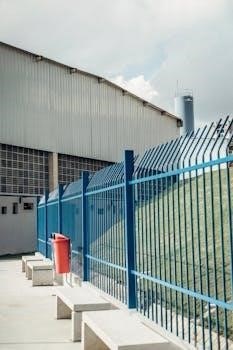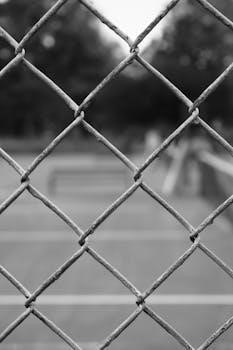Area and Perimeter Worksheets⁚ A Comprehensive Guide
Area and perimeter worksheets are vital tools for students to grasp fundamental geometric concepts. These worksheets offer practice, improving problem-solving skills in various shapes. They are available as PDF downloads, making them easily accessible for both classroom and home use.
Area and perimeter are fundamental concepts in geometry, providing a foundation for understanding spatial relationships and measurements. Area refers to the amount of surface a two-dimensional shape covers, typically measured in square units (e.g., cm², m²). Perimeter, on the other hand, is the total distance around the boundary of a shape, measured in linear units (e.g., cm, m).
Understanding these concepts is crucial for various real-world applications, from calculating the amount of carpet needed for a room (area) to determining the length of fencing required for a garden (perimeter). Area and perimeter worksheets serve as invaluable tools for students to visualize and practice these calculations. These worksheets often include a variety of shapes, such as squares, rectangles, triangles, and circles, each requiring different formulas to determine their area and perimeter.
By working through these PDF worksheets, students develop their problem-solving skills and gain a deeper understanding of geometric principles. The availability of answer keys further enhances the learning process, allowing students to check their work and identify areas where they may need additional support.
Understanding Area Calculations
Calculating area involves determining the amount of surface enclosed within a two-dimensional shape. The specific formula used depends on the shape itself. For instance, the area of a rectangle is found by multiplying its length by its width (Area = length × width), while the area of a square is calculated by squaring the length of one of its sides (Area = side²). Triangles require a slightly different approach, with the area being half the product of the base and the height (Area = ½ × base × height).
Area and perimeter worksheets provide numerous opportunities to practice these calculations. They often present a variety of shapes with given dimensions, challenging students to apply the appropriate formulas and arrive at the correct answer. These worksheets may also include word problems, requiring students to interpret the given information and determine which dimensions are needed to calculate the area.
By working through these problems, students not only memorize the formulas but also develop a deeper understanding of how area is measured and how it relates to the dimensions of different shapes. The PDF format of these worksheets allows for easy printing and distribution, making them a convenient resource for both teachers and parents.
Understanding Perimeter Calculations
Calculating perimeter involves finding the total distance around the outside of a two-dimensional shape. Unlike area, which measures the surface enclosed, perimeter focuses on the length of the boundary. For polygons, such as squares, rectangles, and triangles, the perimeter is simply the sum of the lengths of all its sides. For example, a rectangle with length ‘l’ and width ‘w’ has a perimeter of 2l + 2w.

Area and perimeter worksheets offer a range of exercises to practice perimeter calculations. These worksheets often include shapes with labeled side lengths, requiring students to add them up to find the total perimeter. Some worksheets may present more challenging problems where one or more side lengths are missing, and students need to use other given information, such as the total perimeter or relationships between sides, to deduce the missing values.
Furthermore, word problems on these worksheets can help students understand how perimeter is applied in real-world scenarios. For instance, a problem might involve finding the amount of fencing needed to enclose a garden or determining the length of trim required to decorate a room.
These PDF worksheets are easily accessible and printable, making them a valuable resource for reinforcing perimeter concepts in a practical and engaging manner.
Types of Shapes Covered in Worksheets
Area and perimeter worksheets typically cover a variety of geometric shapes to provide a comprehensive understanding of these concepts. These shapes range from basic polygons to more complex figures, each requiring different formulas and approaches for calculating area and perimeter. Common shapes include squares, rectangles, triangles, and circles.
Squares, with their equal sides, offer a straightforward introduction to area and perimeter calculations; Rectangles, with their length and width, build upon this foundation. Triangles, with their base and height, introduce the concept of half-base times height for area and the sum of three sides for perimeter. Circles, defined by their radius, involve the use of pi (π) in both area (πr²) and circumference (2πr) calculations.
These worksheets often present problems involving these shapes individually or in combination, challenging students to apply the appropriate formulas and problem-solving strategies. Some worksheets also include parallelograms, trapezoids, and other polygons to further expand students’ knowledge. The availability of these worksheets in PDF format makes them easily accessible for practice and reinforcement of geometric concepts.
By working through these exercises, students develop a strong foundation in area and perimeter calculations for various shapes, enhancing their overall mathematical skills.
Squares
Area and perimeter worksheets often start with squares due to their simplicity and foundational role in understanding geometric concepts. A square, defined by its four equal sides and four right angles, provides a straightforward introduction to calculating area and perimeter. The area of a square is found by squaring the length of one side (side * side or side²), while the perimeter is calculated by multiplying the length of one side by four (4 * side).
Worksheets on squares typically include problems where students are given the side length and asked to find the area and perimeter. Conversely, some problems provide the area or perimeter and require students to determine the side length. These exercises help reinforce the relationship between side length, area, and perimeter.
Many area and perimeter worksheets are available in PDF format, making them easily accessible for both classroom and home use. These worksheets often include a variety of problems, ranging from simple calculations to more challenging applications. By working through these exercises, students develop a solid understanding of the properties of squares and their area and perimeter calculations. This understanding serves as a building block for more complex geometric concepts.
Rectangles
Following squares, area and perimeter worksheets commonly feature rectangles, another fundamental shape in geometry. Rectangles, characterized by two pairs of equal sides and four right angles, introduce a slightly more complex calculation compared to squares. The area of a rectangle is determined by multiplying its length by its width (length * width), while the perimeter is found by adding the lengths of all four sides, which can be simplified to 2 * (length + width).
Worksheets dedicated to rectangles often present problems where students are given the length and width and must calculate the area and perimeter. Conversely, some problems may provide the area and one side length, requiring students to find the missing side and then the perimeter, or vice versa. These exercises enhance problem-solving skills and deepen understanding of the relationship between length, width, area, and perimeter.
Numerous area and perimeter worksheets focusing on rectangles are available in PDF format, offering a wide range of practice problems. These worksheets cater to different skill levels, from basic calculations to more challenging word problems. By engaging with these exercises, students solidify their understanding of rectangle properties and master the techniques for calculating their area and perimeter, essential skills for further geometric studies.
Triangles
Area and perimeter worksheets also include triangles, presenting a unique challenge due to their varying shapes and properties. Unlike squares and rectangles, triangles require different formulas depending on their type. The area of a triangle is generally calculated as half the base multiplied by the height (1/2 * base * height), while the perimeter is simply the sum of all three sides.
Worksheets often cover various types of triangles, including equilateral, isosceles, scalene, and right triangles. Each type may require a slightly different approach to find missing side lengths or heights, especially when dealing with area calculations. For example, right triangles can utilize the Pythagorean theorem to find missing sides, while other triangles may require trigonometric functions.

These worksheets often include diagrams with labeled sides and heights, as well as word problems that require students to visualize the triangle and apply the appropriate formulas. Furthermore, readily available area and perimeter worksheets in PDF format, provide ample practice for students to master these concepts. By working through these problems, students develop a deeper understanding of triangle properties and enhance their problem-solving abilities. They also learn to apply formulas for determining the area and perimeter.
Circles
In addition to polygons, area and perimeter worksheets commonly feature circles. Unlike shapes with straight sides, circles require the use of pi (π) in their calculations. The perimeter of a circle, also known as the circumference, is calculated using the formula C = 2πr, where ‘r’ represents the radius. The area of a circle is found using the formula A = πr².
Worksheets on circles often include problems where students are given either the radius or diameter and asked to find the area and circumference. Some problems may require students to work backward, finding the radius or diameter when given the area or circumference. These problems help students to grasp the relationship between the radius, diameter, circumference, and area of a circle.
Many area and perimeter worksheets with answers available in PDF format, provide a variety of practice problems. The worksheets might also include composite figures that combine circles with other shapes, requiring students to apply their knowledge of both circular and polygonal area and perimeter calculations. Working through these problems, students build a solid understanding of circles.
Grade Levels and Targeted Skills
Area and perimeter worksheets are designed to cater to various grade levels, typically starting from 3rd grade and extending through middle school. In the earlier grades, the focus is on understanding the basic concepts of area and perimeter, primarily with squares and rectangles. Students learn to calculate the area by multiplying length and width, and the perimeter by adding up all the sides.
As students progress, the worksheets introduce more complex shapes like triangles, parallelograms, and circles. The problems also become more challenging, involving fractions, decimals, and algebraic expressions. By 5th and 6th grade, students are expected to solve word problems that require them to apply their knowledge of area and perimeter in real-world scenarios.
The targeted skills include not only calculation but also problem-solving, critical thinking, and spatial reasoning. Many area and perimeter worksheets are available in PDF format, providing teachers and parents with a valuable resource for reinforcing these concepts. These worksheets help students visualize geometric shapes and enhance their mathematical abilities.
Benefits of Using Area and Perimeter Worksheets
Area and perimeter worksheets offer numerous benefits for students learning geometry. Firstly, these worksheets provide ample practice opportunities, helping students solidify their understanding of fundamental concepts. By working through various problems, students gain confidence in calculating the area and perimeter of different shapes.
Secondly, area and perimeter worksheets enhance problem-solving skills. Many worksheets include word problems that require students to apply their knowledge in real-world contexts. This helps them develop critical thinking and analytical abilities. Students learn to identify relevant information, formulate equations, and solve for unknown variables.
Thirdly, these worksheets are readily available and accessible. Many websites offer free printable area and perimeter worksheets in PDF format, making them a convenient resource for teachers and parents. These worksheets can be easily integrated into lesson plans or used for homework assignments. Furthermore, the availability of answer keys allows students to check their work and learn from their mistakes. Overall, area and perimeter worksheets are a valuable tool for reinforcing mathematical concepts and improving problem-solving skills.
Free Printable Area and Perimeter Worksheets (PDF)
Accessing free printable area and perimeter worksheets in PDF format is a fantastic resource for both educators and students. These readily available materials offer a convenient way to reinforce learning and practice essential mathematical skills. Numerous websites provide a wide array of worksheets catering to various grade levels and skill levels.
These PDF worksheets often include a variety of shapes, such as squares, rectangles, triangles, and circles, allowing students to apply their knowledge in different contexts. Many worksheets also incorporate word problems, encouraging students to develop critical thinking and problem-solving abilities. Furthermore, the inclusion of answer keys enables students to check their work and identify areas where they may need additional support.

The accessibility of these free printable resources makes them an invaluable tool for supplementing classroom instruction or providing extra practice at home. Teachers can easily download and distribute these worksheets to their students, while parents can use them to support their child’s learning outside of school. With a wealth of options available, finding the perfect area and perimeter worksheets to suit individual needs is easier than ever.
Area and Perimeter Word Problems
Area and perimeter word problems are crucial for developing a deeper understanding of these mathematical concepts. They bridge the gap between abstract formulas and real-world applications, challenging students to apply their knowledge in practical scenarios. These problems often involve everyday situations, such as calculating the amount of fencing needed for a garden or determining the area of a room for carpeting.
By engaging with word problems, students learn to identify relevant information, translate verbal descriptions into mathematical expressions, and select the appropriate formulas to solve the problem. This process enhances their critical thinking, problem-solving, and analytical skills. Furthermore, word problems help students appreciate the relevance of area and perimeter in their daily lives.
Many area and perimeter worksheets include a variety of word problems with varying levels of difficulty, catering to different learning needs. These problems may involve different shapes, composite figures, and even multi-step calculations, providing a comprehensive learning experience. By mastering area and perimeter word problems, students gain a solid foundation in geometry and improve their overall mathematical proficiency.
Advanced Area and Perimeter Concepts

Answer Keys and Solutions
Answer keys and detailed solutions are indispensable components of effective area and perimeter worksheets. They provide students with the means to check their work, identify errors, and understand the correct problem-solving approaches. An answer key simply presents the final answers to the problems, allowing students to quickly assess their overall accuracy.
However, a detailed solution goes a step further by demonstrating the step-by-step process of arriving at the correct answer. This is particularly beneficial for students who struggle with certain concepts or problem types. By examining the solutions, students can gain insights into the underlying logic, learn different strategies, and reinforce their understanding of the formulas and principles involved.
Moreover, answer keys and solutions are valuable resources for teachers and parents. They enable educators to efficiently grade assignments, track student progress, and identify areas where additional instruction may be needed. Parents can use them to support their children’s learning at home, providing guidance and clarification when necessary. The availability of answer keys and solutions ensures that area and perimeter worksheets serve as effective learning tools for students of all levels. Many of these resources are available in PDF format for easy access and printing.
